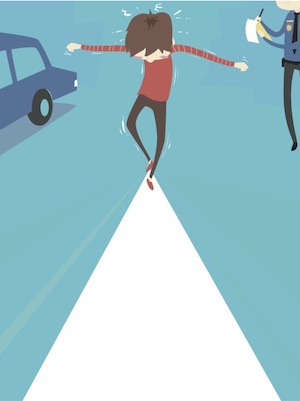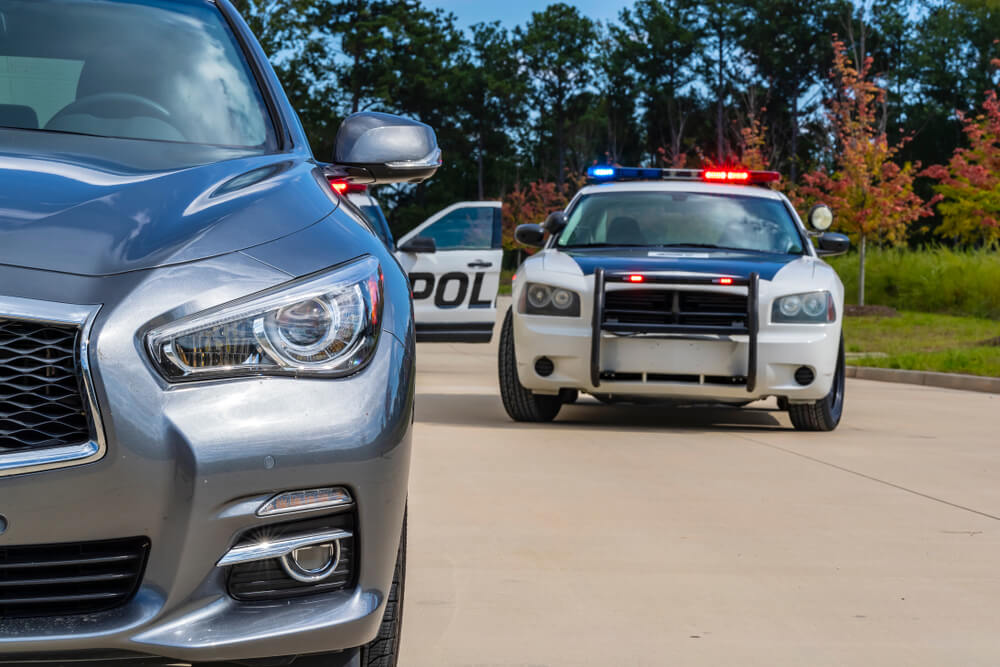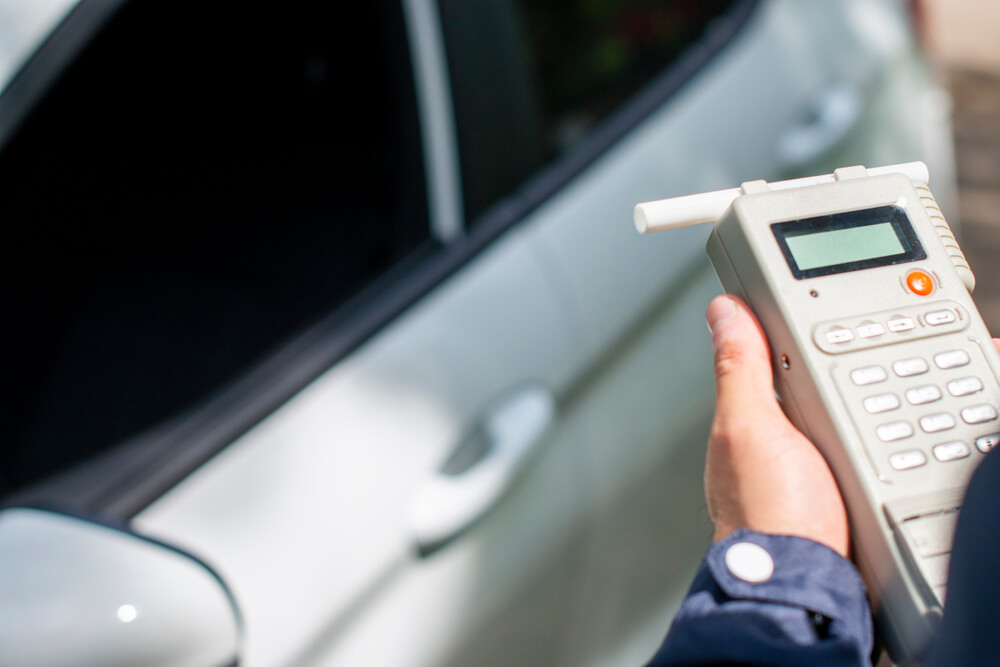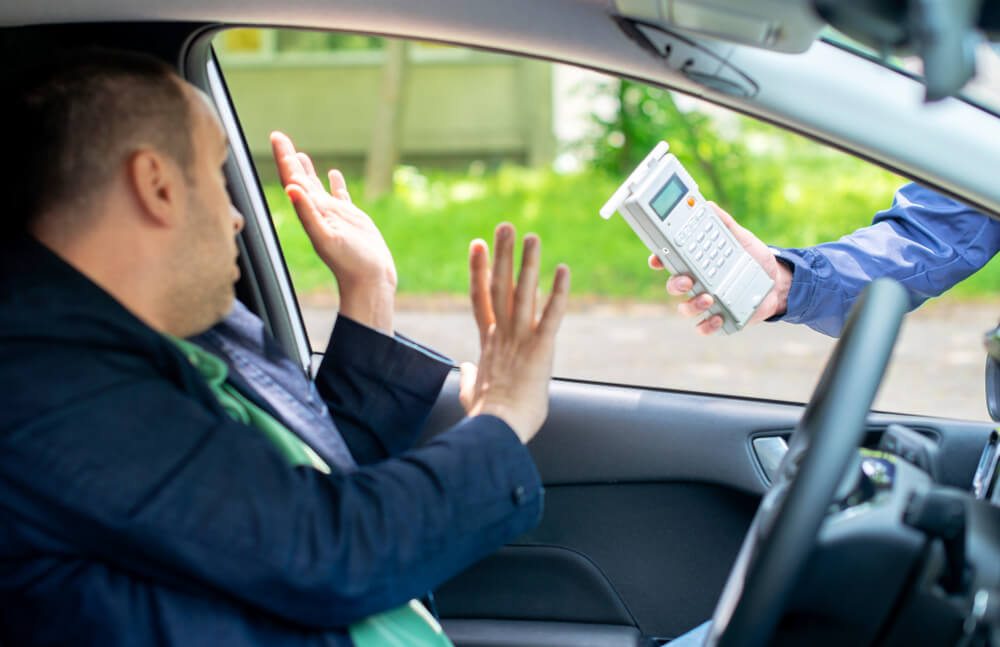Field Sobriety Tests in Chicago Drunk Driving Cases
 Here's a common scenario: You are in your automobile and you have been pulled over for either a possible traffic or vehicle equipment violation. Or perhaps you weren’t even caught driving, but you were parked or maybe standing outside your car and you have now been approached by police intent on finding out what you are up to or whether you "need assistance." The police officer then asks you if you’ve been drinking and indicates to you that he smells the odor of alcohol. Or maybe the Officer asks you if you have been smoking anything, and then indicates that he smells the odor of marijuana coming from your car or person.
Here's a common scenario: You are in your automobile and you have been pulled over for either a possible traffic or vehicle equipment violation. Or perhaps you weren’t even caught driving, but you were parked or maybe standing outside your car and you have now been approached by police intent on finding out what you are up to or whether you "need assistance." The police officer then asks you if you’ve been drinking and indicates to you that he smells the odor of alcohol. Or maybe the Officer asks you if you have been smoking anything, and then indicates that he smells the odor of marijuana coming from your car or person.
What happens next will be of the greatest importance to you and may directly affect whether you will be able to drive in the future and whether your driver’s license will be suspended or revoked. The police will carefully and skillfully push you towards making decisions that are against your best interests. Will you assist the police in gathering valuable evidence that they will then give to the prosecutor to use against you in court? Or will you make wise choices that give your DUI attorney the best chance for success in court?
History of DUI Field Tests (FSTs)
The history and the use of certain tests by Police to detect drunk drivers goes back generations. At first, these tests were invented by police officers in the field and were not uniformly executed. The tests were meant to divide one's attention, and poor performance meant that one was possibly intoxicated and subject to arrest and prosecution. Some of the old tests included: counting backwards from one random number like “84” to another number such as “71”; reciting a portion of the alphabet without singing; touching the tip of the finger to one's tip of the nose; picking up coins (pick up the dime, pick up the penny, etc.) and of course, the one leg stand and the walking heel to toe tests. After some time, it became clear that the tests needed to be made consistent across the board for everyone, with the same set of directions, and the same decision points for the officers to key in on.
Years ago, the National Highway Traffic and Safety Administration (NHTSA) developed a group of tests that if uniformly used by law enforcement across the country would ensure that field investigations were based upon objective factors that were put to the test through research and development, before being authorized for use in the field. Today, these tests have the full weight of recognition in courts across the USA, and are taught to police officers in the Academy and through on-the-job refresher courses. In addition to the One Leg Stand and Walking Heel to Toe, there is another test that was developed through research, and has been approved—the Horizontal Gaze Nystagmus Test (HGN) test.
Purpose of DUI Field Sobriety Testing in Chicago
The stated purpose of these tests, according to the NHTSA training manual, is to allow the Officer in the Field to make an objective assessment of the possible level of impairment of a motorist, and to determine whether or not there exists probable cause to believe that the driver is impaired by alcohol and/or drugs, etc. Although that is the stated purpose of these tests, the performance and scoring of these tests are usually also introduced at trial as evidence of impairment in an effort to prove the guilt of the defendant beyond a reasonable doubt.
Field sobriety tests are tests that are usually performed at or close to the scene of the stop. These tests require the suspect to listen to instructions and perform actions that require coordination. Some of these tests have scorable “clues” or indicators of impairment. Getting a certain score or number of clues means that you failed the test. These tests are used to show that there was probable cause to arrest you for DUI and to prove you were impaired if the case went to trial. You have the right to decline all field sobriety tests.

Types of DUI Field Sobriety Tests
Horizontal Gaze Nystagmus Test
The horizontal gaze nystagmus test (HGN) is usually the first test performed during a DUI stop. The HGN tests for horizontal gaze nystagmus. Horizontal gaze nystagmus is the involuntary jerking of the eyes when they move from side to side from the center position. Horizontal gaze nystagmus typically is observed when a person has consumed alcohol. During the HGN test, the officer will use a stimulus, which is a finger or a pen, and will ask you to look at and follow the stimulus with only your eyes. When the officer is leading your eyes with the stimulus, the officer is looking for clues. There are six possible clues on the test and a determination of four clues means that you failed. Each scored portion of the HGN has two clues because it’s scored for each eye.
The first thing an officer should do before administering the HGN is to check for eyeglasses and contacts. Having eyeglasses or wearing contacts can affect the test. The officer will then read you the instructions which are to keep your feet together and hands at your sides, keep your head still, look at the stimulus, follow the movement of the officer’s stimulus with your eyes only, and to keep looking at the stimulus until you’re told that it’s over. The police officer then should place the stimulus about 12-15 inches away from your nose while keeping it slightly elevated.
During the test, the officer will initially check for resting nystagmus, equal pupil size, and equal tracking. Resting nystagmus is the jerking of the eyes when you are looking straight ahead. NHTSA (National Highway Traffic Safety Administration) standards require one pass for each eye. A pass on the horizontal gaze nystagmus test starts at the center of your face, goes across one eye to the far side of the eye and then back to the center. Many officers will do two passes for each eye on this portion. Once this part is done, the scored portion of the HGN begins. Each clue for the HGN should have at least two passes for each eye. There are three possible clues for each eye. These clues are:
- Lack of smooth pursuit. The officer will move the stimulus side to side and is looking for jerking of the eyes. If the officer observes jerking while moving the stimulus, it’s a clue.
- Distinct and sustained nystagmus at maximum deviation. During this part, the officer will have you hold your eye at maximum deviation for at least four seconds. The nystagmus must be “distinct and sustained” for a minimum of four seconds. If the officer observes jerking that is distinct and sustained, it’s a clue.
- Onset of nystagmus prior to 45 degrees. During this part of the test, the officer is looking for jerking beginning prior to 45 degrees. The officer should be slowly moving the stimulus while checking for onset of nystagmus. If the officer observed jerking prior to 45 degrees, it’s a clue.
If the officer performed the test in compliance with NHTSA standards, there should have been a total of at least fourteen passes. Four out of the six possible clues on the test means that you failed. However, a failed test could have been caused by the police officer improperly conducting the test, you wearing eyeglasses or contacts, or any of the approximately 125 possible causes of nystagmus. In an Illinois Supreme Court case called People v. McKown, the Court held a hearing to see whether the horizontal gaze nystagmus test was admissible as evidence. During the hearing, the Court noted that nystagmus may be a symptom of at least 125 possible diseases or conditions unrelated to alcohol consumption. For example, one possible cause of nystagmus is influenza. At the conclusion of the case, the Illinois Supreme Court determined that due to the reliability of the HGN test, the HGN is only admissible as evidence of alcohol consumption and not impairment. This means that if you failed the horizontal gaze nystagmus test, the prosecution is prohibited from saying that failing the HGN meant that you were impaired.
Vertical Gaze Nystagmus Test
The vertical gaze nystagmus test (VGN) is administered to check for jerking of the eyes when moving the stimulus vertically. It’s usually administered right after the HGN. You maintain the same position as you did during the HGN while the police officer moves the stimulus upward. The stimulus is moved upward until the person’s eyes are elevated as much as possible. The nystagmus must be distinct and sustained for a minimum of four seconds. VGN is usually only present when high doses of alcohol or other drugs have been consumed.
Walk-and-Turn Test
The walk-and-turn test (WAT) is usually administered after the HGN and VGN. The WAT has eight possible clues. Getting two clues means you failed the test and is evidence of impairment. The walk-and-turn test has two parts, which are the instructions stage and the walking phase.
During the instructions stage of the test, the police officer will tell you to place your hands at your sides, put your left foot on a real or imaginary line (if there isn’t an actual line), place your right foot on the line in front of the left foot, and maintain a heel-to-toe position. The officer will demonstrate the test during the instructions phase. The WAT requires nine heel-to-toe steps in the direction away from the officer, followed by a turn using a series of small steps, and then nine heel-to-toe steps toward the direction of the officer. The police officer isn’t required to demonstrate nine heel-to-toe steps in one direction as long as the officer takes an odd number of steps. The two clues during the instructions phase of the test are:
- Starts before instructions are finished
- Unable to maintain balance while listening to instructions - After the instructions stage, the officer will ask you to perform the WAT. The remaining six clues are scored during the walking stage. These clues are:
- Stops walking
- Doesn’t touch heel-to-toe. The police officer is only supposed to record this clue if the space was greater than half an inch.
- Steps off the line
- Uses arms to balance. This clue only should be recorded if one or both arms were raised by six inches or greater from your sides.
- Improper turn. An improper turn happens when you remove the front foot from the line while turning, lose balance while turning, or you don’t follow the instructions of the officer, like pivoting in one movement instead of using a series of small steps.
- Incorrect number of steps
While there is some scientific support for the walk-and-turn test, it’s easy to get two out of eight possible clues even if you aren’t impaired. Other factors may impact your performance of the test, such as medical conditions or injuries that may prevent you from properly performing the test. The officer is supposed to ask about such conditions prior to the performance of the WAT, as such conditions may cause you to fail the test.

One-Leg-Stand
The one-leg-stand (OLS) is usually done after the walk-and-turn test. The OLS has an instructions stage and a balance and counting stage. During the instructions stage, you’re supposed to stand with your feet together and your arms down at your sides. The police officer will demonstrate the OLS during the instructions stage. After the instructions, the officer will ask you to perform the OLS. During the One Leg Stand, you’ll balance on one foot, while raising the other foot about six inches from the ground. Both legs are supposed to be kept straight. The raised foot must also be parallel to the ground. You’ll be asked to count out loud while performing the one-leg-stand until the officer tells you to stop. NHTSA standards indicate that the person should perform the test for 30 seconds. There are four possible clues on the OLS. Two clues means that you failed. The clues are:
- Swaying while balancing
- Raises arms to balance. This clue should only be recorded if one or both arms were raised by at least six inches.
- Hopping
- Putting your foot down
Just like the WAT, injuries or other medical conditions can negatively impact performance on the one-leg-stand test. While the aforementioned tests are the most commonly administered field sobriety tests, there are other tests that officers use during a DUI investigation. These tests are referred to as non-standardized field sobriety tests.
Non-Standardized DUI Field Sobriety Tests
Non-standardized field sobriety tests are tests that are not validated by the NHTSA or any other regulatory agency. A test being non-standardized means that officers aren’t required to follow any specific standards when administering the test. Non-standardized tests also are not accepted by either the medical community or the scientific community for determining impairment due to alcohol. These tests include the Romberg test, finger-to-nose test, finger count test, hand pat test, alphabet test, counting numbers backwards, picking up coins, as well as other non-standardized tests that the arresting officer might have just made up. Police Officers can come up with virtually any test since these tests are non-standardized. An example of a “creative” test is to count the money in your wallet.
Romberg Test
The Romberg test is based on the idea that certain drugs or alcohol speed up or slow your body’s internal clock. The officer will typically have the suspect stand with his or her feet together. The suspect will then tilt their head slightly back and close their eyes. While the suspect’s eyes are closed, the suspect is supposed to count 30 seconds in their head. When the suspect believes that 30 seconds has passed, he or she tilts their head forward and opens their eyes. The police officer may have you also say something like “stop” to indicate that 30 seconds have passed.
Finger-to-Nose Test
The finger-to-nose test requires you to touch the tip of your nose with the tip of your index finger while your eyes are closed, while your head is tilted slightly back. The test typically has three attempts for each hand. The officer will instruct you to use a specific hand on each attempt.
Finger Counting Test
The police officer will typically have the suspect put one hand in front of their body, with the extended palm facing upward. The suspect will use his or her thumb and separately touch the index finger, middle finger, ring, and little finger. The suspect will count out loud “one, two, three, four” for each touch. After doing that, the suspect will be asked to do it in reverse. The test is usually performed for three full sets.
Hand Pat Test
The hand pat test requires you to extend one hand, with the palm facing up, in front of your body. You’ll then place your other hand, palm facing down, on top of the first hand. Using the top hand, you’ll pat the bottom hand and rotate the top hand by 180 degrees, alternating between the palm of the hand and the back of the hand. The bottom hand should remain stationary throughout the test. You will likely be asked to count “one, two, one, two” for each pat.
Alphabet Test
This test is also called the ABC test. Typically, the police officer will ask you to recite a portion of the alphabet. You may even be asked to do it backwards.
Counting Numbers Backwards Test
The officer will instruct you to begin counting down from a specified number and to stop at another specified number. It could be as simple as counting backwards from 10 or from a much greater number.
Picking Up Coins Test
The police officer will drop some coins on the ground. You’ll then be asked to pick the coins up. In some variations, you’ll be directed to squat down, rest an elbow on your knee, and pick up and place the coins in your opposite hand. Sometimes the coins must be picked up in a specific order.
Chemical Sobriety Tests
Police officers use chemical testing as evidence of impaired driving as well. Although there are a number of scientific ways to determine whether alcohol or drugs are present in the body including analysis of hair samples, the most common kinds of chemical tests are the PBT, evidentiary breath test, blood tests and urine tests.
Preliminary Breath Test
The PBT (preliminary breath test) is a portable breath test that is usually administered right after field sobriety tests. The PBT uses a fuel cell to analyze the suspect’s breath sample. The results of the PBT aren’t as accurate as the evidentiary breath test and can’t be used at trial to prove you guilty of DUI. The PBT is used to create probable cause for a DUI arrest. It’s also used in statutory summary suspension hearings to argue that there were reasonable grounds to arrest you for DUI.
Evidentiary Breath Test
The evidentiary breath test is the breath test that’s administered following a DUI arrest. The evidentiary test is usually requested at the police station, but it can be done at the scene as well. The evidentiary breath test machine generally utilizes a combination of infrared sensor and fuel cell technology. There are a few evidentiary breath test machines that are approved for use in Chicago and across Illinois by law enforcement. A commonly used machine is the Intoximeter EC/IR II. The results of the test or refusal of the test are admissible at trial, unlike the PBT.
The police must observe you for 20 minutes prior to administering the evidentiary breath test. The purpose of the observation period is to make sure you haven’t ingested any foreign substances, burped, or regurgitated, as these may skew the results of the test. If there wasn’t a 20 minute observation period, there may be grounds to suppress the results of the breath test.

Blood and Urine Testing
Blood and urine testing is also used by the police to prove a DUI charge. The tests analyze your blood and urine samples for evidence of alcohol and drug use. You’re allowed to refuse blood and/or urine testing. However, if the police obtain a warrant for blood or urine testing, you’ll be forced to take the test.
The Problem with Field Tests
The problem with these tests, is that they test one's ability to divide attention with more dexterity than driving an automobile will ever require: how many times have you had to stand on one leg, counting from One One-Thousand up to Thirty One-Thousand, while holding your leg up in front of you at least 6 inches off of the ground, while holding your arms perfectly at your sides? How many times have you had to walk 9 paces, touching your heel to your toe, while holding your arms at your sides, facing down, counting your steps, executing a specific turn, then doing the same again while on a straight line (real or imaginary)?
The way the tests are graded also makes it very easy for an officer to "decide" to make an arrest. For example, the Walking Heel to Toe Test, also known as the Walk and Turn Test, requires you to stand in a position with one foot directly in front of the other, touching heel to toe, arms at your side, while the police officer demonstrates the test while giving the instructions. If you cannot hold that position, a point is assessed. If you do not take the correct number of steps, a point is assessed. If you stop to steady yourself, sway, raise your arms more than 6 inches from your sides, step off of the line, miss touching heel to toe by ½" or more, or execute the turn improperly, points are assessed. Out of nine (9) possible points, if only 2 (two) are assessed, the Officer is trained to call that performance a failure. With the one leg stand, there are 4 points of observation, and 2 or more is a failure there as well.
As for the HGN test, it is impossible to have independent proof of a result of any performance, because only the police officer executing the test can see the suspect's eyes in motion. The HGN test operates on the theory that a sober person's eyes can smoothly track a moving object, but an intoxicated person's eyes will have a distinct nystagmus, or jerkiness, to the movement. It can best be explained like this: imagine a marble on a glass surface, smoothly rolling across—throw sand on the glass, and see the marble jerk and bounce ever so slightly as it rolls across. Among the problems with this test, some people have a natural nystagmus even when totally sober. Any sort of movement in the field of vision of the suspect can cause involuntary eye focus on the movement. Flashing lights, passing cars, other officers standing in the peripheral moving around; many things can affect a motorist's ability to perform this test.
According to the NHTSA manual, these three tests have been shown to accurately predict that an individual is over the legal limit of 0.08 approximately 70 percent of the time. This means that for every 70 intoxicated motorists that fail these tests, 30 innocent motorists also fail. Yet, Judges and juries rely upon testimony about the performance of these tests every day in finding suspects guilty of DUI.
DUI Field Testing FAQs
Should You Consent to the Evidentiary Breath Test?
You generally shouldn’t consent to the evidentiary breath test, although refusing the breath test may result in a police officer obtaining a warrant for blood and/or urine testing. There are also unique rules about breath tests that relate to CDL (Truck) drivers and those accused of causing great bodily injury to another during a DUI. You can be found guilty of DUI either by the observations of the officers or as a result of chemical testing. An officer’s observations are circumstantial and can be refuted at trial. Blowing a 0.08 or greater means that there exists a rebuttable presumption that you are impaired and therefore guilty of DUI. If the reading is very close to a 0.08, it can be argued that it falls within the margin of error of the machine. A DUI conviction revokes your license in addition to having criminal consequences.

However, there are other consequences for refusing the breath test. Refusing the breath test results in a greater statutory summary suspension than a failed breath test. If it’s your first DUI within the last five years, you are considered a “first offender” by the Illinois Secretary of State (only for purposes of determining the length of your Statutory Summary Suspension, but not for the DUI itself). A failed breath test by a first offender presently results in a six month statutory summary suspension. If you refused to blow, it’s a year suspension. First offenders are eligible for a monitored device driving permit (MDDP), which will allow you drive during the suspension with a Breath Alcohol Ignition Interlock Device (BAIID). If it’s not your first DUI within the last five years, failing the breath test will result in a year suspension and a refusal would result in a three-year suspension.
What If You Didn’t Really Refuse the Breath Test?
If you attempted to blow into the machine, and it didn’t register a BAC reading, it’s generally assumed to be a refusal. Police officers will usually give you multiple attempts to blow into the machine if you weren’t able to provide sufficient air volume before marking it as a refusal. If you believe that you were physically unable to provide a sufficient breath sample for the machine, you can contest the refusal in a statutory summary suspension hearing. In order for you to win on this basis in a statutory summary suspension hearing, you’ll have to demonstrate via testimony and other evidence that you were physically incapable of performing the breath test.
Should You Consent to the PBT?
It’s almost never a good idea to take the PBT because the officer can still arrest you even if you blew under 0.08. Refusing the PBT also doesn’t have any impact on the length of a statutory summary suspension like refusing the evidentiary breath test does.
Will I be Suspended for Refusing DUI Field Tests?
Generally, the best course of action is to inform the police officer that you decline to answer any of his questions or perform field tests (although you are required to immediately produce your license and proof of insurance upon request, as you should when an Officer approaches you following a traffic stop). The police officer is almost certainly going to direct you to exit the vehicle for the purpose of performing certain tests, referred to as Standardized Field Sobriety Tests. Although an Officer has the authority to order occupants of an automobile to exit, in most circumstances, save for one, which will be discussed below, an Officer cannot "order" someone to perform these tests, he can merely "request" the performance, which one can refuse to do.
As such, there is, ordinarily no legal requirement to take these tests. Of course, refusal will most likely result in one's arrest, but then again, the benefit is that there may then be no demonstrably poor performance to bolster the officer's observations, just a refusal, which carries NO recognized "consciousness of guilt" or admission that you refused because you knew you'd fail. Of course, one should be polite and courteous when refusing. A simple, "No, Thank You" suffices, without argument or explanation. Your driving privileges cannot be suspended simply because you refused to do these field tests. Although a suspension may follow a DUI arrest if the driver refuses chemical testing or if sufficient drugs or alcohol are present after chemical testing, the officer still has to show reasonable grounds to believe that you were impaired by alcohol or whatever at the time of driving or actual physical control of the automobile.
The one exception so far to this rule was recently created by our Illinois Legislature, under Section 11-501.9 of the Vehicle Code, which allows that anyone with a Medical Marijuana Card has given implied consent to the performance of Standardized Field Sobriety Tests upon request of an police officer during a DUI investigation, where the officer has an independent reasonable basis to believe the motorist is under the influence of Cannabis. Refusal to perform Field Tests in this context will result in a Statutory Summary Suspension of the motorist for 12 months, while performance/failure of the tests will result in a 6 month suspension. Still, the basic premise of these tests is the same: to help the officers obtain evidence that they will use against you in the prosecution of a DUI arrest. A polite refusal to comply with these tests will tell anyone else much less about your level of impairment than actual failure of the tests ever will.
Think of it this way: Silence leaves others with doubts as to your ignorance, yet speaking removes any doubt. So it is with Field Tests. Refusal may leave one wondering whether or not you are impaired, whereas failure of the tests may leave no room for doubt.
Contact Our Chicago DUI Field Sobriety Test Attorneys
If you have been arrested for a DUI, you need the help of a knowledgeable lawyer to fight for you and for your rights in court. Contact us online, or call us 24 hours a day at (312) 644-0444. The Chicago drunk and drugged driving defense lawyers at Mitchell S. Sexner & Associates LLC have the knowledge and experience to make sure that your rights are fully protected. We have handled thousands of such cases before and are ready to help you as well.
